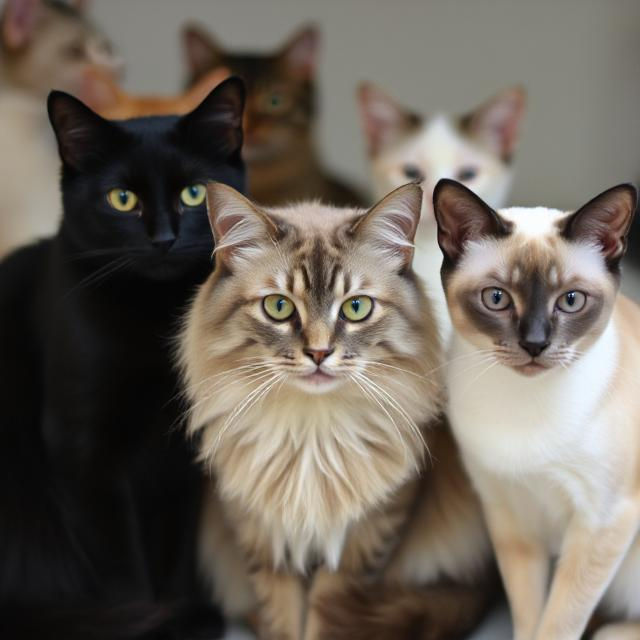From Wild Hunter to Cuddly Companion: The Remarkable History of the Domestic Cat
- Millie Zeiler
- Jul 13
- 3 min read
For thousands of years, cats have held a unique and often revered place in human society. From their mysterious origins as wild hunters to their current status as cherished household companions, the journey of the domestic cat is a fascinating tale intertwined with human civilization.

The Dawn of Domestication: A Mutually Beneficial Relationship
Unlike many other domesticated animals, cats were not actively herded or bred for specific tasks by early humans. Instead, their domestication was a more organic process, largely driven by a convergence of interests between felines and the nascent agricultural societies of the Fertile Crescent.
Where Cat History Began
Around 10,000 to 12,000 years ago, as humans began to settle down and cultivate crops, they inadvertently created a new food source for rodents. These rodents, in turn, attracted wildcats – specifically the African Wildcat (Felis lybica). These adaptable and solitary predators, with their keen hunting instincts, found an abundant supply of prey in human settlements.

Early farmers, undoubtedly plagued by rodent infestations that threatened their valuable grain stores, likely tolerated the presence of these natural pest controllers. The cats, benefiting from a steady food supply and perhaps even some protection from larger predators, gradually grew accustomed to human proximity. Over generations, the least fearful and most tolerant individuals thrived, leading to a subtle shift in their behavior and genetics.
Archaeological evidence supports this theory. In 2004, the discovery of a 9,500-year-old burial site in Cyprus revealed a human buried alongside a cat, predating Egyptian evidence of cat domestication by several millennia. This suggests that the relationship between humans and cats was established quite early in the agricultural revolution.
Ancient Egypt: Cats as Sacred Symbols and Guardians

While the initial domestication likely occurred in the Fertile Crescent, it was in ancient Egypt that cats truly ascended to a place of prominence and reverence. For the Egyptians, cats were not just pest controllers; they were seen as sacred animals, embodying grace, fertility, and divine protection.
The goddess Bastet, often depicted with the head of a lioness or a domestic cat, was the deity of home, fertility, childbirth, and protection against evil spirits and disease. Cats were mummified, given elaborate burials, and even afforded legal protections. Harming a cat was considered a grave offense, sometimes punishable by death. The export of cats from Egypt was strictly controlled, highlighting their immense value. This period solidified the cat's image as a creature of elegance and mystique, an image that persists to this day.
Cats Across Continents: From Trade Routes to Global Companions
From Egypt, domestic cats began to spread across the globe, primarily along trade routes. Phoenician traders likely carried them to Europe, where they continued to be valued for their rodent-catching abilities on ships and in granaries.
In ancient Greece and Rome, cats were appreciated for their practicality, though they didn't hold the same sacred status as in Egypt. They were companions, mousers, and sometimes even symbols of liberty.
The spread of Catholicism in Europe, however, brought a period of hardship for cats. Associated with pagan rituals and superstitions, particularly during the Middle Ages, black cats, in particular, were often persecuted and linked to witchcraft. This unfortunate period led to a decline in their numbers, which some historians believe contributed to the spread of the Black Death, as rat populations flourished unchecked.
The Renaissance and Beyond: A Return to Favor
By the Renaissance, the cat's fortunes began to turn. Their practical value as pest controllers was once again recognized, and their aesthetic appeal was increasingly appreciated. Artists like Leonardo da Vinci depicted them with grace and realism, further solidifying their place in human culture.
The Age of Exploration saw cats accompanying sailors on long voyages, helping to control rodents on ships and thus preventing damage to cargo and the spread of disease. This further facilitated their global distribution.
The Modern Cat: From Barn to Bedside
The Victorian era marked a significant turning point in the cat's journey towards being a pampered pet. Cat shows became popular, fostering the development of distinct breeds and encouraging selective breeding for specific traits. The perception of cats shifted from purely utilitarian to companions valued for their beauty, personality, and affection.
Today, cats are among the most popular pets worldwide. They are celebrated for their independent yet affectionate nature, their playful antics, and their calming presence. From the sleek Siamese to the fluffy Maine Coon, the diversity of cat breeds reflects centuries of human interaction and appreciation.
The history of the cat is a testament to the remarkable adaptability of a species and the enduring bond it has forged with humanity. From a wild predator drawn to human settlements by the promise of an easy meal, the cat has evolved into a beloved member of millions of households, a silent observer of our lives, and a constant reminder of the wild beauty that still resides within our homes.




Comments